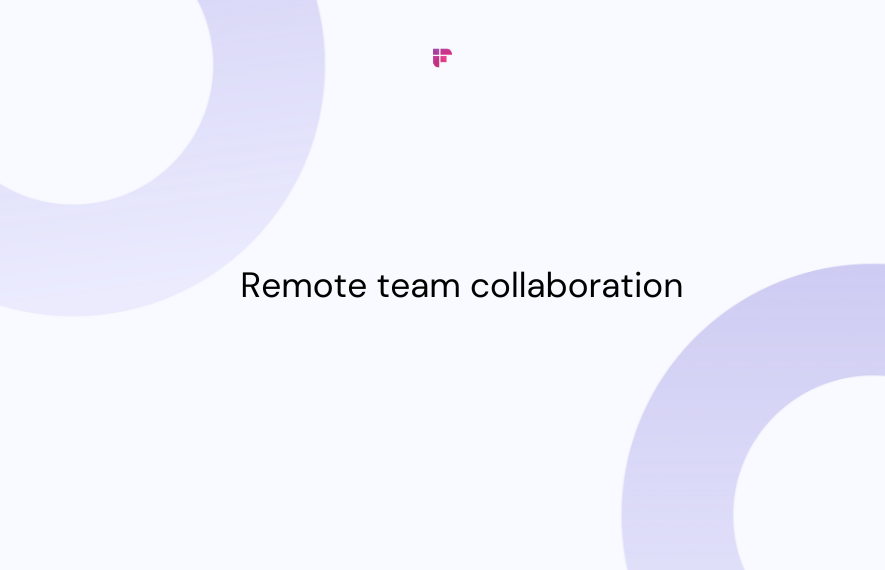With an increasing amount of jobs switching to remote-based work due to the pandemic, it has become increasingly essential to maintain effective communication between teams and individuals.
It is natural to wonder how to collaborate effectively when your team is remote in such a scenario. Companies are adapting to the situation by providing various tools and practices to augment this process.
A report by Slack states by late summer 2020, more workers in the U.S. (44%) and the U.K. (45%) were primarily working from home than in the office.
But despite the efforts put in, remote working has some inherent challenges when it comes to collaboration. It can be difficult to remain connected, ideate, solve problems, and improve the business’s profitability when the team members are not in the same office space or building.
Likewise, it can be challenging to get your whole team to shift to a new way of communicating.
While office-based working naturally progresses towards improving collaboration, the remote working approach requires a more conscious effort.
So, where do you start? The reality is that there isn’t a singular ‘way’ to fix or improve this and is more about what processes are in place to facilitate it.
So how can a company rewire its current process? First, let’s understand what precisely remote work collaboration is and what are the main challenges faced.
What is Remote Work Collaboration?

Remote work collaboration is the ability to engage as a team from anywhere in the world. It can also refer to the remote communication methods required by international companies with teams across the globe.
On that note, remote collaboration is not just limited to the physical distance between teams. Other factors like the size and the varying skill levels of team members and their operational styles affect their synergy and teamwork.
Improving the team’s productivity using these practices and tools essentially enhances remote work collaboration and the business's overall profitability.
Remote collaboration bridges the distance limitations by the usage of suitable tools. These collaboration tools offer help based on the requirements needed by the company.
Video conferences and project management interfaces are examples of features to expect from remote collaboration tools.
However, it is crucial to understand that remote collaboration is virtually useless regardless of the tools at your disposal if the team(s) engagement isn’t universal. So, by and large, the essential thing to mandate is to make sure everyone on your team is on board!
You might also like:

Why Should You Focus on Improving Remote Collaboration?

Imagine if you had the perfect team to make the best product, but their communication is so disjointed that the end product isn’t what you wanted. Here are some reasons why improving remote collaboration is essential.
No standards, broken communication lines, and a lack of new processes can lead to ineffective remote project collaboration.
Effective Communication While Working Remotely
Since remote collaboration involves text, video, and audio-based communication, it is vital to ensure everyone can communicate in a non-intrusive way. That means avoiding using slang words, maintaining a consistent tone, sending messages appropriately, and considering the other team members.
Transparency is also essential here. Team members who can freely contact one another regardless of their position can be huge for improving their morale and enabling kinetic teamwork.
In simple words, the less time the team needs to understand what each other is trying to say, the more time spent doing the actual work.
Mandating an Internal Process
Each person may have their style of communicating when your team isn’t in the confines of shared office space. Making it easy for your team to ensure the best communication between each other by setting down some house rules can enhance remote collaboration.
Forming an agreement so that your team can abide by the set standards can eliminate problems before they even arise. Assigning the remote collaboration tools and productivity apps your team will use and defining the main communication channels will ensure greater effectiveness.
Enhanced Problem Solving and Innovative Thinking
Remote working can be just the thing your team members need to come up with something new! Some people may not think of new ideas and develop solutions when distracted by their colleagues at an office.
A survey by Flexjobs reveals that 65% of respondents are more productive in their home office than in a traditional workplace.
Things that contribute to this productiveness are fewer distractions and interruptions, less stress from no commute, no office politics, and a personal/quiet environment.
The Effect of Remote Work on Collaboration: Remote Collaboration Challenges

Even though remote working has many positives, it is crucial to outline and identify some of the remote work challenges companies and remote workers face in this process. But transitioning to remote working can be tricky.
Unplugging after work, loneliness, distractions, and collaborating/communication are some of the biggest problems. Indeed, it may seem like trivial problems to solve when in an in-office environment, but it is entirely different in a remote setting.
These issues can sometimes be so significant that they might even be enough to collapse the company’s entire structure.
However, problems with remote collaboration can vary based on the perspective. That is to say, the issues faced by companies and employees/remote workers can be the same and quite different from each other. Let’s take a look at some of the most significant issues on both sides.
Employee Engagement
People can get bored with waiting for replies to conventional emails. Managers need to be diligent when it comes to remote teams.
Not reporting to other team members is a common problem. When the higher authorities aren't present to check up on you, employees may slack off instead.
Employees can also choose to refrain from responding to their colleagues. That can lead to broken communication lines and loneliness amongst themselves. That also affects team building and synergy as it is a team effort.
But the lack of any project management software can pose a significant gap in how your employees even start collaborating.
Distorted Communication
Communication gaps are often the result of poor leadership or lack of leadership. When in a remote environment, all team leads have to step up their employee management skills.
When the team lacks a sense of direction, inefficient practices and lackluster output start to emerge.
When team members don't have an explicit purpose (which is more likely to happen in a remote setting), they will start to alienate themselves as they don't know how to proceed. In the worst-case scenario, it can lead to them leaving the job or going rogue! The exact opposite of what you want as an organization.
Despite the various advances in different remote working tools being available, companies may not have introduced or embedded these into their work environment.
Different Time Zones and Cultures

As with many remote-jobs, your team is likely spread out over various cities or even countries. On that note, it isn't easy to truly understand how they work and communicate.
Think about it; your team members are not going to have a 100% global mindset. That is a perfect storm to create a confusing atmosphere, where people with different backgrounds may be left in the dark and cause misunderstandings!
Any lack of face-to-face interaction via remote working apps makes a gap in context on what is trying to be said.
Commitment Issues
Motivation can be a real problem for remote teams. Perhaps an employee wants to have more interaction, and he starts looking for a new job.
Or he may feel left out because of some gap in communication lines and leave the job. Or the environment is confusing, and he doesn't know what he should be doing.

If there isn't a constant line of communication between teams, then morale levels dip. It is up to the company and managers to create an atmosphere where people feel looked after. That isn't easy in a remote setting, as you have no real tangible control over how people will behave.
Time Management Issues
How do you control different employees in different time zones to not force them out of their comfort zone? An employee is responsible for their work, and managing a virtual team is the company's responsibility.
Yet, it cannot be easy to catch up with everyone when half your team is sleeping on the other side of the planet.
When it isn't clear how much employees should commit, they can quickly overwork and burn out. It’s ubiquitous in situations where the amount of work done isn't reported or controlled.
Lack of deadlines or deliverables creates a warped sense of time management, leading to disgruntled team members.
Distractions
It's our old friend Mr. Distraction again. It doesn't matter where you are or where you're working from; distractions just always come to interfere with us. Sending your team into a remote-work setup will undoubtedly introduce some new and old annoyances.
Unlike some of the previous challenges of remote working, distractions can sometimes be entirely out of the control of the affected people's hands.
Is the back street neighbor playing loud music? Is a dog somewhere off in the distance barking endlessly? Is your favorite game of football happening as you work? Regardless of what the distraction is, it is tough for some people not to give in!
And the worst part about all this is that you only have the tools at your disposal to try to get them back on track as a team leader or manager.
But it would help if you also had some systematic changes and ensure that work doesn't get delayed even with these distractions. Implementing these is not as clear-cut as a regular in-office job tough.
Overcoming Those Challenges

It’s not all doom and gloom when you have some of the problems listed above. As with many things, if there’s a problem, it’s got a solution. And that’s what we’ll look at right now.
How to overcome Employee Engagement/Collaboration issues?
Simply put, conventional channels like Email just aren't going to cut it in a remote-working environment. Having access to something flexible and fast is a top priority. Fortunately, there are various project management tools and apps that can alleviate this.
Slack has become the go-to platform for remote teams all across the globe. It provides all the necessary features like group chats, instant messaging, availability statuses, notifications, file sharing, and more into an easy-to-use interface.
Onboarding your entire team by understanding how to use slack effectively like this can dramatically increase their productivity, focus, and motivation levels. Another relatively new entrant is Microsoft Teams, which saw a dramatic surge in its usage over the last three years.
Identifying any niche cases where a productivity app can help is essential. A simple example can be doing all your documentation on Google Drive instead of another word processor. A video conferencing app like Zoom lets you have face time with the team to catch up and conduct meetings.

How to fix communication issues, taking into account different time zones and cultures?
As a manager or team lead, it's up to you to mandate how communication takes place. Giving your team regular updates, checking in on them, and setting guidelines will create an unobstructed communication line and help overcome remote work challenges.
Providing these written guidelines removes any ambiguity. If your team is located across the country or globe, it's essential to take their time zones and cultural implications.
Come up with ways to interact despite the above considerations as well. If possible, try to organize a collaborative meeting in person or via video call as frequently as it's needed, like a monthly all-hands meeting.
Ask your teammate to follow the right time management techniques to stay productive and efficient despite the array of distractions.
Overcoming Commitment Issues
As much as it's frowned upon, hand-holding your employees and keeping track of what they're up to can give great insights into how your remote operation works.
Letting them know what they should document and how often they should is an excellent practice in the long run. Optionally, having tracking software that logs how much work each team member has done can help if you desire.
Frequent one-on-one meetings between the team leads and other members can be very effective at rooting out any issues they might have with any given thing. Make sure the team follows online meeting etiquette for a more productive outcome.
At the same time, these meetings can provide empathy for the employees if they have an emergency. Despite all the available automation tools, it is still essential to have a human feeling within the team.
Dealing with Time Management Issues
One of the best ways to eliminate this issue is to use workflow templates. These are task lists or project templates that you can use to queue up or work up a plan.
For example, your company's Public Relations workflow needs to be followed immediately by certain people on the communications team as a top priority. The team manager can create a new project based on the immediate plan to assign and schedule several tasks to as many people as required.
Due to their critical priority and relative deadlines immediately after the project started, the tasks will push all other work to other days after the emergency is over for everyone on the team.
Users can predetermine deadlines and add critical task priorities in the template, for example. Lucidchart is one of the popular diagramming and flowcharting apps available.
There are also lots of choices for scheduling apps. Toggl and Spark are great choices to keep the team in check and provide collaborative tools for easy engagement.
Overcoming Distractions
For many remote workers, this is the bane that never seems to leave them. What can you do as an employer to help your team focus on work?
For starters, recommending your team install a few anti-distraction apps can help tremendously. For instance, an app like FocusMe can block sites and apps on your laptop/desktop.
Some work from home tips will further help them get comfortable with this new style of working.
As a remote worker, blocking all notifications, pings, and messages from your mobile device and computer can prevent you from getting side-tracked.
Even when using an app like Slack, you can mute specific channels that do not concern you to avoid unnecessary desktop notifications and so on. Keep all non-essential devices and knick-knacks away from you to ensure you don't get distracted.

Having a daily planner to show you what work needs to be done for the day is another excellent way to keep you focused. Bunching up all tiny and menial tasks together and doing it in one go can save a lot of time.
Scheduling all meetings at the end of the day instead of scattered throughout will allow for maximum productivity.
And finally, designating an office space in your home which ensures you can work without any disturbances by itself can be hugely beneficial.
Some Best Remote Collaboration Tools

- Slack: By far, one of the most used team collaboration apps, with various integrations available.
- Fireflies.ai: The best tool at async collaboration to transcribe and record all your meetings into shareable files. The Fireflies ai Meeting Notetaker makes it easy to parse and smart search key points and topics.
- Zoom: One of the most well-known video conferencing apps ever created. Even if you haven't used it, you've probably heard of it.
- Microsoft Teams: Loaded with many features, including inbuilt video/audio chatting, it's well on its way to being one of the most popular collaborative tools.
- GitHub: An iconic platform for coders and developers offering a variety of automation tools.
- Trello: A straightforward and easy-to-use collaboration tool, ideal for fast-paced work environments.
- Zapier: A workflow automation tool that has garnered quite a reputation and is known for integrating several simple apps.
- Dropbox: A remote collaboration app well known for its extensive file sharing features.
Starting or switching to remote working can sound daunting at first, but thanks to the many advances and innovations today, we have a plethora of tools at our disposal to make our lives a lot easier.
The technical and tangible limitations of remote working don't matter whether you've got a great team and some helpful little apps to guide you.
Illustration by Freepik.com













